Iron tsuba of round form pierced (sukashi) in a chessboard fashion and decorated with linear (sen-zōgan) and cast (suemon-zōgan) brass inlay, including symbols of the swastika, flower-lozenge, maple leaf, pine needle, etc. on both sides; rim and openings outlined with brass inlay. Nakagō-ana plugged with copper fittings (sekigane).
Momoyama period. End of the 16th - beginning of the 17th century. Dimensions: Diameter: 75.5; Thickness: 4.5 mm.-

-
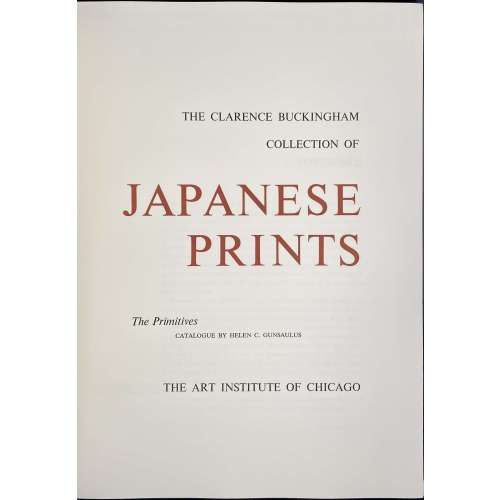 Two volumes, each bound in red cloth with gilt lettering to spine, black endpapers, TEG, and matching red cloth slipcases with black lettering to front. Vol. 1: The Clarence Buckingham collection of Japanese prints: The Primitives / Catalogue by Helen C. Gunsaulus. — [Chicago]: Art Institute of Chicago, 1955. Pagination: 1st leaf blank, 2nd leaf half-title, verso blank, [i, ii] – t.p. in red and black, copyright to verso, iii-vi, [vii] faux-title “The catalogue”, 1-284 [285] colophon, limitation: 500 numbered copies, this is № 476. Title-page: THE CLARENCE BUCKINGHAM | COLLECTION OF | JAPANESE PRINTS | The Primitives | CATALOGUE BY HELEN C. GUNSAULUS | THE ART INSTITUTE OF CHICAGO || Vol. 2: The Clarence Buckingham collection of Japanese prints: Volume 2 / Catalogue by Margaret O. Gentles. — [Chicago]: Art Institute of Chicago, 1965. Pagination: 1st leaf blank, 2nd leaf half-title, verso blank, [i, ii] – t.p. in red and black, copyright to verso, iii-vi, [vii] faux-title “The catalogue”,1-307 [2] blank/ colophon, limitation: 1000 copies (unnumbered). Title-page: VOLUME II | THE CLARENCE BUCKINGHAM | COLLECTION OF | JAPANESE PRINTS | Harunobu, Koryūsai, Shigemasa, their followers and contemporaries | Catalogue by Margaret O. Gentles | THE ART INSTITUTE OF CHICAGO 1965 || Contributors: Clarence Buckingham (American, 1854 – 1913) Helen C. Gunsaulus (American, 1886 – 1954) Margaret O. Gentles (American, 1905 – 1969)
Two volumes, each bound in red cloth with gilt lettering to spine, black endpapers, TEG, and matching red cloth slipcases with black lettering to front. Vol. 1: The Clarence Buckingham collection of Japanese prints: The Primitives / Catalogue by Helen C. Gunsaulus. — [Chicago]: Art Institute of Chicago, 1955. Pagination: 1st leaf blank, 2nd leaf half-title, verso blank, [i, ii] – t.p. in red and black, copyright to verso, iii-vi, [vii] faux-title “The catalogue”, 1-284 [285] colophon, limitation: 500 numbered copies, this is № 476. Title-page: THE CLARENCE BUCKINGHAM | COLLECTION OF | JAPANESE PRINTS | The Primitives | CATALOGUE BY HELEN C. GUNSAULUS | THE ART INSTITUTE OF CHICAGO || Vol. 2: The Clarence Buckingham collection of Japanese prints: Volume 2 / Catalogue by Margaret O. Gentles. — [Chicago]: Art Institute of Chicago, 1965. Pagination: 1st leaf blank, 2nd leaf half-title, verso blank, [i, ii] – t.p. in red and black, copyright to verso, iii-vi, [vii] faux-title “The catalogue”,1-307 [2] blank/ colophon, limitation: 1000 copies (unnumbered). Title-page: VOLUME II | THE CLARENCE BUCKINGHAM | COLLECTION OF | JAPANESE PRINTS | Harunobu, Koryūsai, Shigemasa, their followers and contemporaries | Catalogue by Margaret O. Gentles | THE ART INSTITUTE OF CHICAGO 1965 || Contributors: Clarence Buckingham (American, 1854 – 1913) Helen C. Gunsaulus (American, 1886 – 1954) Margaret O. Gentles (American, 1905 – 1969) -
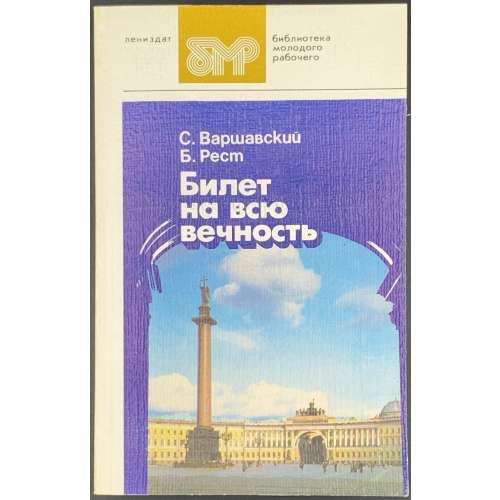 A book about the history and collections of The Hermitage museum in St. Petersburg during the October revolution of 1917. Paperback, 20 x 12.5 cm, 16mo, serial pictorial wrappers, blurb to rear; [1]-516 68( plates, not paginated) 7-816; pp.: [2] 3-204 [4]: 208 pages + 16 pages of plates, not paginated, 120 leaves, incl. plates. Title-page: «БМР» device // библиотека | молодого | рабочего | — | С. ВАРШАВСКИЙ | Б. РЕСТ | БИЛЕТ | НА ВСЮ | ВЕЧНОСТЬ | ПОВЕСТЬ ОБ ЭРМИТАЖЕ | В ТРЕХ ЧАСТЯХ | ЧАСТЬ ТРЕТЬЯ | ЛЕНИЗДАТ • 1986 || Sergei Petrovich Varshavsky [Сергей Петрович Варшавский] (Jewish-Russian, 1906 – 1980). B. Rest [Б. Рест; Юлий Исаакович Шапиро] (Jewish-Russian, fl. 1940 – 1980).
A book about the history and collections of The Hermitage museum in St. Petersburg during the October revolution of 1917. Paperback, 20 x 12.5 cm, 16mo, serial pictorial wrappers, blurb to rear; [1]-516 68( plates, not paginated) 7-816; pp.: [2] 3-204 [4]: 208 pages + 16 pages of plates, not paginated, 120 leaves, incl. plates. Title-page: «БМР» device // библиотека | молодого | рабочего | — | С. ВАРШАВСКИЙ | Б. РЕСТ | БИЛЕТ | НА ВСЮ | ВЕЧНОСТЬ | ПОВЕСТЬ ОБ ЭРМИТАЖЕ | В ТРЕХ ЧАСТЯХ | ЧАСТЬ ТРЕТЬЯ | ЛЕНИЗДАТ • 1986 || Sergei Petrovich Varshavsky [Сергей Петрович Варшавский] (Jewish-Russian, 1906 – 1980). B. Rest [Б. Рест; Юлий Исаакович Шапиро] (Jewish-Russian, fl. 1940 – 1980). -
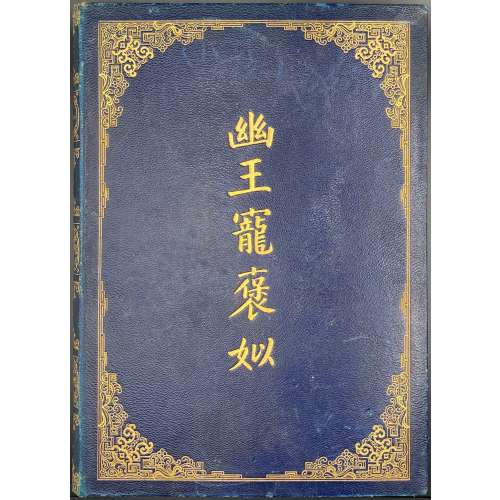 Description: Hardcover, in-folio, 32 x 23.5 cm, bound in dark blue morocco, boards and spine richly decorated in gilt, front cover gilt-lettered in Chinese [幽王寵褒姒], pictorial endpapers, laid paper with unicorn watermark, margins uncut, printing performed by Joh. Enschedé (Haarlem), pp. [10] 1-210 [6], total 226 pages, collated π5 1-532 χ2, first and last leaves blank, total 113 leaves plus 7 plates after Franz von Bayros, some signed; adorned with woodcut borders, frames, head- and tailpieces throughout. The binding work was done by Hübel und Denck (Leipzig) based on designs by Paul Renner. Title-page: DAS | SCHÖNE | MÄDCHEN | VON PAO | — | EIN CHINESISCHER | ROMAN VON | OTTO JULIUS BIERBAUM | — | PRACHTAUSGABE | MIT BILDERN VON BAYROS | — | Bei Joh. Enschedé en Zonen in | Haarlem gedruckt für Georg | Müllers Verlag in München || Catalogue raisonné: The amorous drawings of the Marquis von Bayros. — New York: Cythera Press, 1968. The Beautiful Maiden of Pao, pp. 153-8. Contributors: Otto Julius Bierbaum (German, 1865 – 1910) – author. Franz von Bayros (Austrian, 1866 – 1924) – artist. Johannes Enschedé (Dutch, 1708 – 1780) – printer. Joh. Enschedé (Haarlem) – printer. Hübel und Denck (Leipzig) – bookbinder. Paul Friedrich August Renner (German, 1878 – 1956) – designer.
Description: Hardcover, in-folio, 32 x 23.5 cm, bound in dark blue morocco, boards and spine richly decorated in gilt, front cover gilt-lettered in Chinese [幽王寵褒姒], pictorial endpapers, laid paper with unicorn watermark, margins uncut, printing performed by Joh. Enschedé (Haarlem), pp. [10] 1-210 [6], total 226 pages, collated π5 1-532 χ2, first and last leaves blank, total 113 leaves plus 7 plates after Franz von Bayros, some signed; adorned with woodcut borders, frames, head- and tailpieces throughout. The binding work was done by Hübel und Denck (Leipzig) based on designs by Paul Renner. Title-page: DAS | SCHÖNE | MÄDCHEN | VON PAO | — | EIN CHINESISCHER | ROMAN VON | OTTO JULIUS BIERBAUM | — | PRACHTAUSGABE | MIT BILDERN VON BAYROS | — | Bei Joh. Enschedé en Zonen in | Haarlem gedruckt für Georg | Müllers Verlag in München || Catalogue raisonné: The amorous drawings of the Marquis von Bayros. — New York: Cythera Press, 1968. The Beautiful Maiden of Pao, pp. 153-8. Contributors: Otto Julius Bierbaum (German, 1865 – 1910) – author. Franz von Bayros (Austrian, 1866 – 1924) – artist. Johannes Enschedé (Dutch, 1708 – 1780) – printer. Joh. Enschedé (Haarlem) – printer. Hübel und Denck (Leipzig) – bookbinder. Paul Friedrich August Renner (German, 1878 – 1956) – designer. -
 Artist: Utagawa Kunisada [歌川 国貞] a.k.a. Utagawa Toyokuni III [三代歌川豊国] (Japanese, 1786 – 1865). No publisher seal, no date or censor seal; probably a private printing. Signed: Kunisada ga [国貞画] in a red double gourd cartouche. Media: Untrimmed fan print (uchiwa-e), 231 x 294 mm, with the use of mica and black lacquer.
Artist: Utagawa Kunisada [歌川 国貞] a.k.a. Utagawa Toyokuni III [三代歌川豊国] (Japanese, 1786 – 1865). No publisher seal, no date or censor seal; probably a private printing. Signed: Kunisada ga [国貞画] in a red double gourd cartouche. Media: Untrimmed fan print (uchiwa-e), 231 x 294 mm, with the use of mica and black lacquer. -
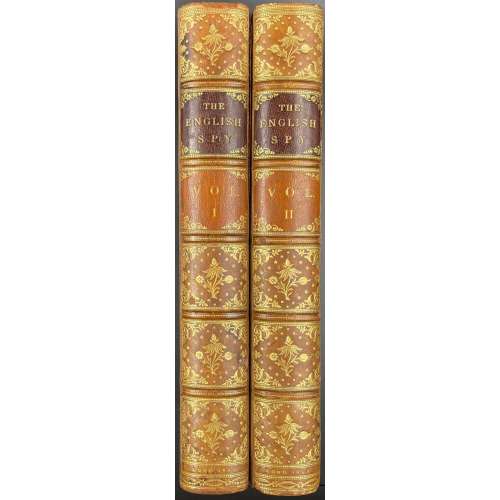 Two volumes 23.2 x 15.6 cm, uniformly bound in full polished calf by Riviere and Son (signed on fep verso), boards with triple gilt fillet border, spine with raised bands, gilt in compartments, gilt-lettered labels; dark blue endpapers, armorial bookplate of William Jennings with the motto “Honor Virtutis Premium” to front pastedown. Vol. 1: THE | ENGLISH SPY: | An Original Work | CHARACTERISTIC, SATIRICAL, AND | HUMOROUS. | COMPRISING | SCENES AND SKETCHES IN EVERY RANK OF SOCIETY, | BEING | PORTRAITS | OF THE | Illustrious, Eminent, Eccentric, and Notorious. | DRAWN FROM THE LIFE | BY BERNARD BLACKMANTLE. | THE ILLUSTRATIONS | DESIGNED BY | ROBERT CRUIKSHANK. | {vignette w/inscription: ‘By Frolic, Mirth, and Fancy gay, | Old Father Time is borne away.’ | — | LONDON : | PUBLISHED BY SHERWOOD, JONES, AND CO. | PATERNOSTER-ROW. | – | 1825. || Collation: [a]8 b4 B-H8 I4 K2 L-Z8 2A-2E8 2F3; total 221 leaves Pagination: [i-iii] iv-xxiii [xxiv] [1-3] 4-417 [418]; total 442 pages. Illustrations: 35 coloured plates, 1 uncoloured plate, and 29 woodcuts in text, incl vignette on title, all but four by Robert Cruikshank, 1 by G. M.B rightly (p. 335), 1 by T. Wageman (p. 413), and 2 by T. Rowlandson (pp. 411 and 416) Vol. 2: THE | ENGLISH SPY: | An Original Work | CHARACTERISTIC, SATIRICAL, AND | HUMOROUS. | COMPRISING | SCENES AND SKETCHES IN EVERY RANK OF SOCIETY, | BEING | PORTRAITS | OF THE | Illustrious, Eminent, Eccentric, and Notorious. | DRAWN FROM THE LIFE | BY BERNARD BLACKMANTLE. | THE ILLUSTRATIONS | DESIGNED BY | ROBERT CRUIKSHANK. | — | VOL. II. | — | {vignette w/inscription: ‘By Frolic, Mirth, and Fancy gay, | Old Father Time is borne away.’ | — | LONDON : | PUBLISHED BY SHERWOOD, GILBERT, AND PIPER, | PATERNOSTER-ROW. | – | 1826. || Collation: [A]-Z8 2A-2C8; total 208 leaves. [i-iii] iv-xv [xvi] [1-3] 4-399 [400]; total 416 pages. Illustrations: 36 coloured plates and 25 woodcuts in text. Catalogue raisonné: Martin-Hardie pp. 191-2; Tooley pp. 266-9; Abbey 325, pp.272-4 (see reflections regarding the ‘first issue’). Contributors: Charles Molloy Westmacott (British, c. 1788 – 1868) – author. Isaac Robert Cruikshank (British, 1789 – 1856) – artist, engraver. G. M. Brightly (British, fl. 1809 – 1827) – artist, engraver. Thomas Charles Wageman (British, 1787-1868) – artist, engraver Thomas Rowlandson (British, 1757 – 1827) – artist. Thomas Davison (British, 1794 – 1826) – printer. Sherwood, Jones, and Co. (London) – publisher. Sherwood, Gilbert, and Piper (London) – publisher. William Jennings – provenance
Two volumes 23.2 x 15.6 cm, uniformly bound in full polished calf by Riviere and Son (signed on fep verso), boards with triple gilt fillet border, spine with raised bands, gilt in compartments, gilt-lettered labels; dark blue endpapers, armorial bookplate of William Jennings with the motto “Honor Virtutis Premium” to front pastedown. Vol. 1: THE | ENGLISH SPY: | An Original Work | CHARACTERISTIC, SATIRICAL, AND | HUMOROUS. | COMPRISING | SCENES AND SKETCHES IN EVERY RANK OF SOCIETY, | BEING | PORTRAITS | OF THE | Illustrious, Eminent, Eccentric, and Notorious. | DRAWN FROM THE LIFE | BY BERNARD BLACKMANTLE. | THE ILLUSTRATIONS | DESIGNED BY | ROBERT CRUIKSHANK. | {vignette w/inscription: ‘By Frolic, Mirth, and Fancy gay, | Old Father Time is borne away.’ | — | LONDON : | PUBLISHED BY SHERWOOD, JONES, AND CO. | PATERNOSTER-ROW. | – | 1825. || Collation: [a]8 b4 B-H8 I4 K2 L-Z8 2A-2E8 2F3; total 221 leaves Pagination: [i-iii] iv-xxiii [xxiv] [1-3] 4-417 [418]; total 442 pages. Illustrations: 35 coloured plates, 1 uncoloured plate, and 29 woodcuts in text, incl vignette on title, all but four by Robert Cruikshank, 1 by G. M.B rightly (p. 335), 1 by T. Wageman (p. 413), and 2 by T. Rowlandson (pp. 411 and 416) Vol. 2: THE | ENGLISH SPY: | An Original Work | CHARACTERISTIC, SATIRICAL, AND | HUMOROUS. | COMPRISING | SCENES AND SKETCHES IN EVERY RANK OF SOCIETY, | BEING | PORTRAITS | OF THE | Illustrious, Eminent, Eccentric, and Notorious. | DRAWN FROM THE LIFE | BY BERNARD BLACKMANTLE. | THE ILLUSTRATIONS | DESIGNED BY | ROBERT CRUIKSHANK. | — | VOL. II. | — | {vignette w/inscription: ‘By Frolic, Mirth, and Fancy gay, | Old Father Time is borne away.’ | — | LONDON : | PUBLISHED BY SHERWOOD, GILBERT, AND PIPER, | PATERNOSTER-ROW. | – | 1826. || Collation: [A]-Z8 2A-2C8; total 208 leaves. [i-iii] iv-xv [xvi] [1-3] 4-399 [400]; total 416 pages. Illustrations: 36 coloured plates and 25 woodcuts in text. Catalogue raisonné: Martin-Hardie pp. 191-2; Tooley pp. 266-9; Abbey 325, pp.272-4 (see reflections regarding the ‘first issue’). Contributors: Charles Molloy Westmacott (British, c. 1788 – 1868) – author. Isaac Robert Cruikshank (British, 1789 – 1856) – artist, engraver. G. M. Brightly (British, fl. 1809 – 1827) – artist, engraver. Thomas Charles Wageman (British, 1787-1868) – artist, engraver Thomas Rowlandson (British, 1757 – 1827) – artist. Thomas Davison (British, 1794 – 1826) – printer. Sherwood, Jones, and Co. (London) – publisher. Sherwood, Gilbert, and Piper (London) – publisher. William Jennings – provenance -
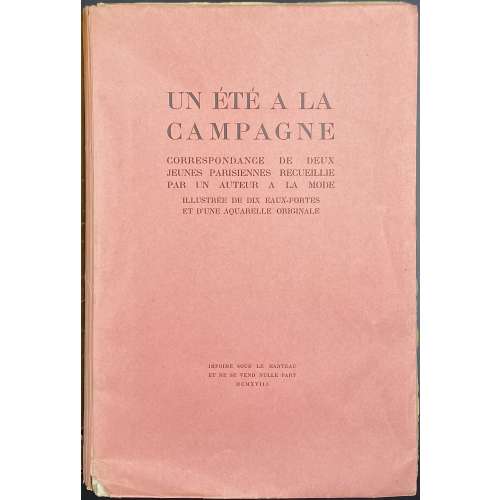 Description: softcover, 25.5 x 16.5 cm, pink French flapped wrappers with black lettering, printed on laid paper watermarked “ARCHES (France)”, with 10 plates (etchings) bound in and 1 plate (coloured etching) laid in, extraneous to collation, with tissue guards; pp.: ffl, [2] h.t., [2] t.p., 1- 151 [152] [4] colophon, blank, ffl; some pages uncut; margins untrimmed. Title-page: UN ÉTÉ A LA | CAMPAGNE | CORRESPONDANCE DE DEUX | JEUNES PARISIENNES RECUEILLIE | PAR UN AUTEUR A LA MODE | ILLUSTRÉE DE DIX EAUX-FORTES | ET D’UNE AQUARELLE ORIGINALE | {blank} | IMPRIMÉ SOUS LE MANTEAU | ET NE SE VEND NULLE PART | MCMXVIII || Limitation: a print run of 165 copies, of which this is № 129 on Arches à la forme paper. Cat. Raisonné: Dutel III № 2545, p. 397; Honesterotica. Contributors: Gustave Droz (French, 1832 – 1895) – author (presumable) Frans de Geetere (Belgian, 1895 – 1968) – artist/engraver
Description: softcover, 25.5 x 16.5 cm, pink French flapped wrappers with black lettering, printed on laid paper watermarked “ARCHES (France)”, with 10 plates (etchings) bound in and 1 plate (coloured etching) laid in, extraneous to collation, with tissue guards; pp.: ffl, [2] h.t., [2] t.p., 1- 151 [152] [4] colophon, blank, ffl; some pages uncut; margins untrimmed. Title-page: UN ÉTÉ A LA | CAMPAGNE | CORRESPONDANCE DE DEUX | JEUNES PARISIENNES RECUEILLIE | PAR UN AUTEUR A LA MODE | ILLUSTRÉE DE DIX EAUX-FORTES | ET D’UNE AQUARELLE ORIGINALE | {blank} | IMPRIMÉ SOUS LE MANTEAU | ET NE SE VEND NULLE PART | MCMXVIII || Limitation: a print run of 165 copies, of which this is № 129 on Arches à la forme paper. Cat. Raisonné: Dutel III № 2545, p. 397; Honesterotica. Contributors: Gustave Droz (French, 1832 – 1895) – author (presumable) Frans de Geetere (Belgian, 1895 – 1968) – artist/engraver -
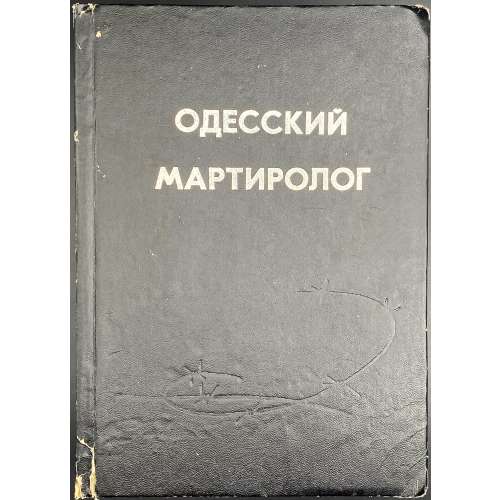 Hardcover volume, 24.5 x 17.5 cm, bound in black buckram with blind barbed wire design and silver lettering to front cover and spine, pp.: [2] 3-750 [2]. Одеський мартиролог: Данi про репресованих Одеси i Одеськоï областi за роки радянськоï влады (Серiя «Одеського Меморiалу») (Том 1) / Уклад.: Л. В. Ковальчук, Г. О. Разумов— Одеса : ОКФА, 1997. Title-page: (in rules) СЕРИЯ «ОДЕССКОГО МЕМОРИАЛА» | ОДЕССКИЙ | МАРТИРОЛОГ | ТОМ 1 | Одесса | ОКФА | 1997 || ISBN: 966-571-065-9 Ковальчук, Лидия Всеволодовна Разумов, Георгий Александрович
Hardcover volume, 24.5 x 17.5 cm, bound in black buckram with blind barbed wire design and silver lettering to front cover and spine, pp.: [2] 3-750 [2]. Одеський мартиролог: Данi про репресованих Одеси i Одеськоï областi за роки радянськоï влады (Серiя «Одеського Меморiалу») (Том 1) / Уклад.: Л. В. Ковальчук, Г. О. Разумов— Одеса : ОКФА, 1997. Title-page: (in rules) СЕРИЯ «ОДЕССКОГО МЕМОРИАЛА» | ОДЕССКИЙ | МАРТИРОЛОГ | ТОМ 1 | Одесса | ОКФА | 1997 || ISBN: 966-571-065-9 Ковальчук, Лидия Всеволодовна Разумов, Георгий Александрович -
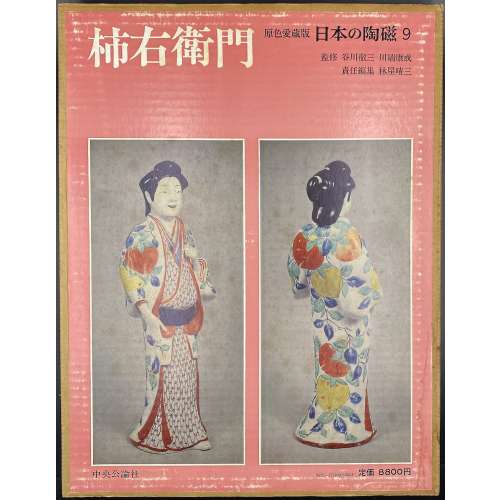 Hardcover volume, 35.2 x 27 cm, bound in grey cloth, blind stamped characters to front, brown characters to spine, in a glassine dust jacket, in a double slipcase, the outer case pictorial paper over cardboard, 36 x 28 cm, pp.: [4] [1] 2-104 (plates with photographs of 206 items), [2] 107-138 [4]. Kakiemon [柿右衛門] – book title. 日本の陶磁 – Japanese ceramics, series title. Contributors: Yasunari Kawabata [川端 康成] (Japanese, 1924 – 1972) – author. Tetsuzo Tanikawa [谷川 徹三] (Japanese, 1895 – 1989) – author. Seizo Hayashiya [林屋晴三] (Japanese, 1928 – 2017) – editor. Chūōkōron-sha [中央公論社] – publisher.
Hardcover volume, 35.2 x 27 cm, bound in grey cloth, blind stamped characters to front, brown characters to spine, in a glassine dust jacket, in a double slipcase, the outer case pictorial paper over cardboard, 36 x 28 cm, pp.: [4] [1] 2-104 (plates with photographs of 206 items), [2] 107-138 [4]. Kakiemon [柿右衛門] – book title. 日本の陶磁 – Japanese ceramics, series title. Contributors: Yasunari Kawabata [川端 康成] (Japanese, 1924 – 1972) – author. Tetsuzo Tanikawa [谷川 徹三] (Japanese, 1895 – 1989) – author. Seizo Hayashiya [林屋晴三] (Japanese, 1928 – 2017) – editor. Chūōkōron-sha [中央公論社] – publisher. -
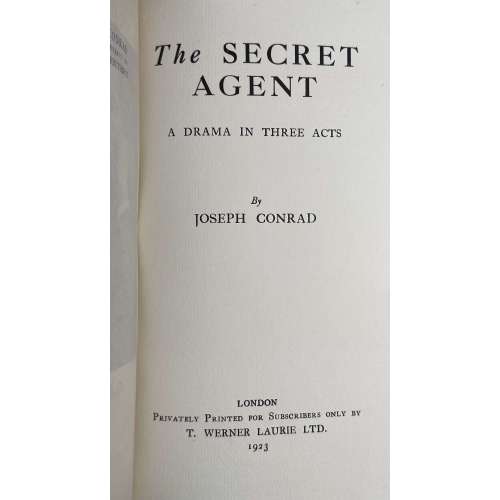 Hardcover volume, 24 x 15 cm, bound in quarter parchment over pale blue cloth, paper label to spine, pale blue dust jacket with a paper label, another label bound in at the end, printed on thick laid paper, untrimmed, uncut, pp. [4] blank, [2] blank/advert., [2] h.t./blank, t.p./imprint (riverside press Ltd.), [2] limitation/blank, [2] persons/blank, [1] 2-185 [3], photogravure portrait frontispiece by Emery Walker with captioned tissue guard. Title-page: The SECRET AGENT | A DRAMA IN THREE ACTS | by | JOSEPH CONRAD | LONDON | Privately Printed for Subscribers ONLY BY | T. WERNER LAURIE LTD. | 1923 || Edition: Limited edition of 1,000 copies sighed by the author; this is copy № 12. Catalogue Raisonné: Keating № 79 / p. 169. Seller’s Description: one of 1000 copies signed by the author, photogravure portrait frontispiece by Emery Walker, endpapers lightly browned, original parchment-backed boards, dust-jacket, spine lightly browned with 2 small staining spots, ends a little creased, uncut and unopened, overall an excellent copy, 8vo, 1923. Contributors: Joseph Conrad (Polish-British, 1857 – 1924) – author. Thomas Werner Laurie (British, 1866 – 1944) – publisher. Emery Walker (British, 1851 – 1933) – artist. The Riverside Press Limited (Edinburgh) – printer. First edition: [LIB-2762.2021] Joseph Conrad. The secret agent: a simple tale. — London: Methuen & Co., [1907]
Hardcover volume, 24 x 15 cm, bound in quarter parchment over pale blue cloth, paper label to spine, pale blue dust jacket with a paper label, another label bound in at the end, printed on thick laid paper, untrimmed, uncut, pp. [4] blank, [2] blank/advert., [2] h.t./blank, t.p./imprint (riverside press Ltd.), [2] limitation/blank, [2] persons/blank, [1] 2-185 [3], photogravure portrait frontispiece by Emery Walker with captioned tissue guard. Title-page: The SECRET AGENT | A DRAMA IN THREE ACTS | by | JOSEPH CONRAD | LONDON | Privately Printed for Subscribers ONLY BY | T. WERNER LAURIE LTD. | 1923 || Edition: Limited edition of 1,000 copies sighed by the author; this is copy № 12. Catalogue Raisonné: Keating № 79 / p. 169. Seller’s Description: one of 1000 copies signed by the author, photogravure portrait frontispiece by Emery Walker, endpapers lightly browned, original parchment-backed boards, dust-jacket, spine lightly browned with 2 small staining spots, ends a little creased, uncut and unopened, overall an excellent copy, 8vo, 1923. Contributors: Joseph Conrad (Polish-British, 1857 – 1924) – author. Thomas Werner Laurie (British, 1866 – 1944) – publisher. Emery Walker (British, 1851 – 1933) – artist. The Riverside Press Limited (Edinburgh) – printer. First edition: [LIB-2762.2021] Joseph Conrad. The secret agent: a simple tale. — London: Methuen & Co., [1907] -
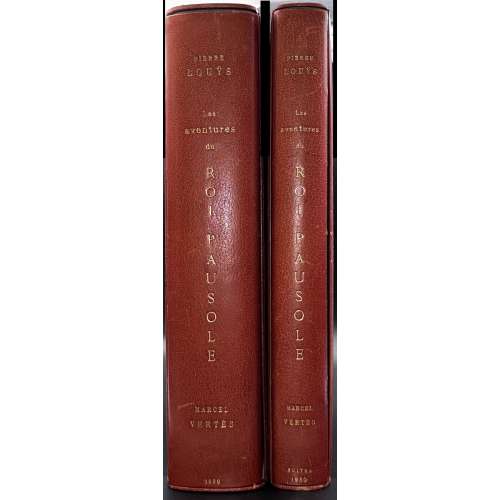 Two volumes in owner’s uniform so called Jansenist binding by someone Alix (signed in gilt inside), gilt lettering to spine, each in a slipcase. Vol. 1: full crimson morocco 32.5 x 26 x 6.5 cm in a 33.3 x 27 x 7 cm slipcase, cloth endpapers, all edges gilt, publisher’s wrappers preserved, autographed drawing by Vertès to h.t. “à monsieur Willard | bien sympathiquement | Vertès | Paris 1930”. Collation: 3 blanks, front wrapper, 2 blanks, [10] h.t./limit., t.p., art., dedic., person., [2] 3-487 [488 blank], [2] coloph., 3 blanks, spine, 3 blanks; 74 dry-point illustrations by Marcel Vertès within collation; printed on thick wove paper by ‘Arches’ watermarked “Pausole & Vertès”. Title-page (red and black): LES AVENTURES | DU | ROI PAUSOLE | de | PIERRE LOUŸS | {vignette} | AUX DÉPENS D'UN AMATEUR | PARIS, MCMXXX || Limitation: CETTE ÉDITION DU ROMAN | DE |PIERRE LOUŸS | LES AVENTURES DU ROI PAUSOLE | A ÉTE COMPOSE EN CARACTÈRE GARAMOND DU CORPS 18 | ET IMPRIMEE SUR VÉLIN A LA FORME DES PAPETERIES | D' ARCHES FILIGRANÉ | PAUSOLE & VERTÈS | ELLE EST ILLUSTRÉE DE SOIXANTE-QUATORZE | POINTES-SÈCHES ORIGINALES | DE | VERTÈS | SON TIRAGE A ÉTÉ STRICTEMENT LIMITÉ A | QUATRE-VINGT-DIX-NEUF EXEMPLAIRES NUMÉROTÉS | DE 1 A 99 ET CONTENANT : | 1° LA SUITE DES CUIVRES AVEC REMAROUES. | 2° UNE SUITE DES 15 PLANCHES REFUSÉES. | IL A ÉTÉ TIRÉ EN OUTRE, POUR L' ARTISTE ET LES COLLABORATEURS, | QUELQUES EXEMPLAIRES NOMINATIFS, DONT DEUX IMPRIMÉS SUR PAPIER | CHIFFE D'AUVERGNE A LA MAIN | EXEMPLAIRE | № 9 || Colophon: Cet ouvrage, établi aux dépens de m. L. Givaudan, a été achevé d'imprimer le quinze novembre mil neuf cent trente, pour le texte, sur les presses de R. Coulouma, maitre imprimeur a Argenteuil, H. Barthélemy, directeur, et pour les pointes-sèches, dans les ateliers de «La Tradition", a Paris. Limited edition of 99 copies, this is copy № 9. Vol. 2: Three-quarters crimson morocco over cloth outlined gilt, 32.7 x 27.8 x 4 cm in a 33.3 x 28.2 x 4.3 cm slipcase, cloth endpapers, all edges gilt, printed on thick wove paper by ‘Arches’ watermarked “Pausole & Vertès”. Collation: 3 blanks, 74 unpaginated leaves of plates (main suite avec remarque), blank, 15 leaves of plates (refusées), t.p./limit., blank, 30 leaves of plates (15 prints in two states each, with and without ‘remarks’) titled Au pays du Roi Pausole, 3 blanks. Title-page (red and black): AU PAYS | DU | ROI PAUSOLE | Quinze cuivres | gravés par un artiste | inconnu | de la suite | du Roi | ❦ | —| TRYPHÈME. MCMXXX. || Limitation: IL A ÉTÉ TIRÉDE CETTE SUITE | DE POINTES-SÈCHES VINGT- | CINQ EXEMPLAIRES SUR VÉ- | LIN A LA FORME DES PAPETE- | RIES ARCHES AU FILIGRANE | DE PAUSOLE. CES SUITES NON | MISES DANS LE COMMERCE | SONT RÉSERVÉES A SA MAJES- | TÉ, AUX REINES PRÉFÉRÉES | PARMI LL. AA. RR. ET A QUEL- | QUES FIDÈLES SERVITEURS. | № 13 || Limited edition of 25 copies, this is copy № 13; Enriched with an original copper plate with one of the illustrations. Marcel Willard (French, – provenance. Catalogue raisonné: Dutel (III) 1057; Nordmann (II) № 307; Vokaer 26. Ref.: honesterotica.com Contributors: Pierre Louÿs (French, 1870 – 1925) – author. Marcel Vertès [Marcell Vértes] (Jewish-Hungarian-French, 1895 – 1961) – artist. Léon Givaudan (French, 1875 – 1936) – publisher. Seller's description:Les Aventures du Roi Pausole. Paris, Aux dépens d'un amateur, 1930. 2 volumes in-4, maroquin rouge janséniste, tranches dorée, couverture et dos, emboîtage. Le volume de suites est relié en demi-maroquin rouge. (Alix). Ouvrage illustré de 74 pointes-sèches de Marcel Vertès. Tirage à 99 exemplaires sur vélin d'Arches, comportant la suite des cuivres avec remarque, ainsi qu'une suite des 15 planches refusées. Exemplaire enrichi d'une plaque de cuivre ayant servi à une des illustrations, d'un dessin avec envoi autographe signé de l'artiste sur la page de faux-titre et d'une double suite des 15 pointes-sèches par un artiste inconnu intitulée Au Pays du roi Pausole. Dos légèrement passés.
Two volumes in owner’s uniform so called Jansenist binding by someone Alix (signed in gilt inside), gilt lettering to spine, each in a slipcase. Vol. 1: full crimson morocco 32.5 x 26 x 6.5 cm in a 33.3 x 27 x 7 cm slipcase, cloth endpapers, all edges gilt, publisher’s wrappers preserved, autographed drawing by Vertès to h.t. “à monsieur Willard | bien sympathiquement | Vertès | Paris 1930”. Collation: 3 blanks, front wrapper, 2 blanks, [10] h.t./limit., t.p., art., dedic., person., [2] 3-487 [488 blank], [2] coloph., 3 blanks, spine, 3 blanks; 74 dry-point illustrations by Marcel Vertès within collation; printed on thick wove paper by ‘Arches’ watermarked “Pausole & Vertès”. Title-page (red and black): LES AVENTURES | DU | ROI PAUSOLE | de | PIERRE LOUŸS | {vignette} | AUX DÉPENS D'UN AMATEUR | PARIS, MCMXXX || Limitation: CETTE ÉDITION DU ROMAN | DE |PIERRE LOUŸS | LES AVENTURES DU ROI PAUSOLE | A ÉTE COMPOSE EN CARACTÈRE GARAMOND DU CORPS 18 | ET IMPRIMEE SUR VÉLIN A LA FORME DES PAPETERIES | D' ARCHES FILIGRANÉ | PAUSOLE & VERTÈS | ELLE EST ILLUSTRÉE DE SOIXANTE-QUATORZE | POINTES-SÈCHES ORIGINALES | DE | VERTÈS | SON TIRAGE A ÉTÉ STRICTEMENT LIMITÉ A | QUATRE-VINGT-DIX-NEUF EXEMPLAIRES NUMÉROTÉS | DE 1 A 99 ET CONTENANT : | 1° LA SUITE DES CUIVRES AVEC REMAROUES. | 2° UNE SUITE DES 15 PLANCHES REFUSÉES. | IL A ÉTÉ TIRÉ EN OUTRE, POUR L' ARTISTE ET LES COLLABORATEURS, | QUELQUES EXEMPLAIRES NOMINATIFS, DONT DEUX IMPRIMÉS SUR PAPIER | CHIFFE D'AUVERGNE A LA MAIN | EXEMPLAIRE | № 9 || Colophon: Cet ouvrage, établi aux dépens de m. L. Givaudan, a été achevé d'imprimer le quinze novembre mil neuf cent trente, pour le texte, sur les presses de R. Coulouma, maitre imprimeur a Argenteuil, H. Barthélemy, directeur, et pour les pointes-sèches, dans les ateliers de «La Tradition", a Paris. Limited edition of 99 copies, this is copy № 9. Vol. 2: Three-quarters crimson morocco over cloth outlined gilt, 32.7 x 27.8 x 4 cm in a 33.3 x 28.2 x 4.3 cm slipcase, cloth endpapers, all edges gilt, printed on thick wove paper by ‘Arches’ watermarked “Pausole & Vertès”. Collation: 3 blanks, 74 unpaginated leaves of plates (main suite avec remarque), blank, 15 leaves of plates (refusées), t.p./limit., blank, 30 leaves of plates (15 prints in two states each, with and without ‘remarks’) titled Au pays du Roi Pausole, 3 blanks. Title-page (red and black): AU PAYS | DU | ROI PAUSOLE | Quinze cuivres | gravés par un artiste | inconnu | de la suite | du Roi | ❦ | —| TRYPHÈME. MCMXXX. || Limitation: IL A ÉTÉ TIRÉDE CETTE SUITE | DE POINTES-SÈCHES VINGT- | CINQ EXEMPLAIRES SUR VÉ- | LIN A LA FORME DES PAPETE- | RIES ARCHES AU FILIGRANE | DE PAUSOLE. CES SUITES NON | MISES DANS LE COMMERCE | SONT RÉSERVÉES A SA MAJES- | TÉ, AUX REINES PRÉFÉRÉES | PARMI LL. AA. RR. ET A QUEL- | QUES FIDÈLES SERVITEURS. | № 13 || Limited edition of 25 copies, this is copy № 13; Enriched with an original copper plate with one of the illustrations. Marcel Willard (French, – provenance. Catalogue raisonné: Dutel (III) 1057; Nordmann (II) № 307; Vokaer 26. Ref.: honesterotica.com Contributors: Pierre Louÿs (French, 1870 – 1925) – author. Marcel Vertès [Marcell Vértes] (Jewish-Hungarian-French, 1895 – 1961) – artist. Léon Givaudan (French, 1875 – 1936) – publisher. Seller's description:Les Aventures du Roi Pausole. Paris, Aux dépens d'un amateur, 1930. 2 volumes in-4, maroquin rouge janséniste, tranches dorée, couverture et dos, emboîtage. Le volume de suites est relié en demi-maroquin rouge. (Alix). Ouvrage illustré de 74 pointes-sèches de Marcel Vertès. Tirage à 99 exemplaires sur vélin d'Arches, comportant la suite des cuivres avec remarque, ainsi qu'une suite des 15 planches refusées. Exemplaire enrichi d'une plaque de cuivre ayant servi à une des illustrations, d'un dessin avec envoi autographe signé de l'artiste sur la page de faux-titre et d'une double suite des 15 pointes-sèches par un artiste inconnu intitulée Au Pays du roi Pausole. Dos légèrement passés. -
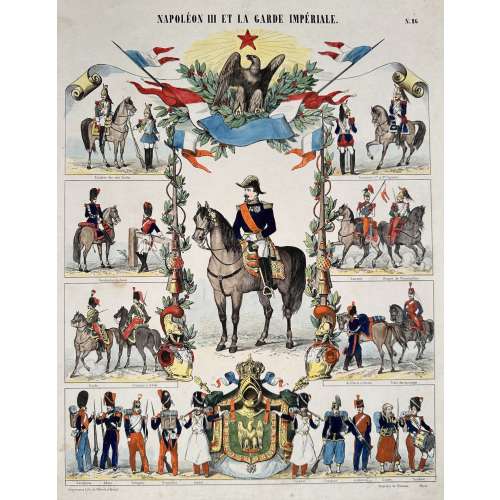 Hand-coloured woodcut on wove paper, 460 x 356 mm; black ink stamp “5055” to reverse. Top centre: "NAPOLÉON III ET LA GARDE IMPÉRIALE"; right: "№ 86". Napoléon III ahorseback in middle, beside (top to bottom): Escadron des cent Gardes — Cuirassiers 1er et 2me regiment; Gendarmes à cheval. — Lancier., Dragon de l’Impératrice.; Guide., Chasseur à cheval. — Artillerie à cheval, Train des équipages.; Gendarme. Génie. Voltigeur. Grenadier. Sapeur. Sapeur. Chasseur. Artillerie. Zouave. Tambour. Bottom left: Imprimerie Lith. de Pellerin à Épinal; right: Propriété de l’Éditeur. Déposé. Jean Charles Pellerin (French, 1756 – 1836) – printer/publisher.
Hand-coloured woodcut on wove paper, 460 x 356 mm; black ink stamp “5055” to reverse. Top centre: "NAPOLÉON III ET LA GARDE IMPÉRIALE"; right: "№ 86". Napoléon III ahorseback in middle, beside (top to bottom): Escadron des cent Gardes — Cuirassiers 1er et 2me regiment; Gendarmes à cheval. — Lancier., Dragon de l’Impératrice.; Guide., Chasseur à cheval. — Artillerie à cheval, Train des équipages.; Gendarme. Génie. Voltigeur. Grenadier. Sapeur. Sapeur. Chasseur. Artillerie. Zouave. Tambour. Bottom left: Imprimerie Lith. de Pellerin à Épinal; right: Propriété de l’Éditeur. Déposé. Jean Charles Pellerin (French, 1756 – 1836) – printer/publisher. -
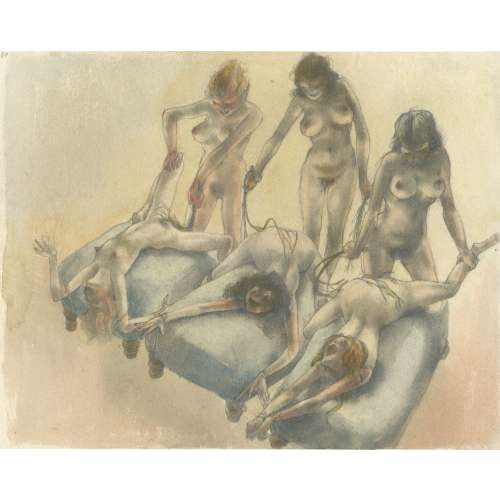 Watercolour on laid paper watermarked “HOLLAND”, 255 x 324 mm, number “10” ms pencil in the upper left corner, remnants of hinges to verso; unsigned. Attributed to Otto Rudolf Schatz (Austrian, 1900 – 1961).
Watercolour on laid paper watermarked “HOLLAND”, 255 x 324 mm, number “10” ms pencil in the upper left corner, remnants of hinges to verso; unsigned. Attributed to Otto Rudolf Schatz (Austrian, 1900 – 1961). -
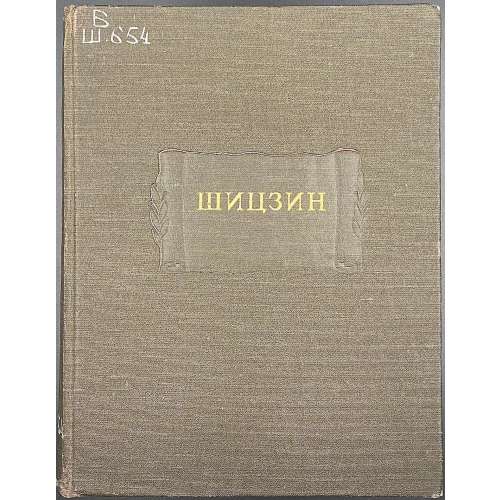 Title (black and red): ШИЦЗИН | [device} | ИЗДАНИЕ ПОДГОТОВИЛИ | А.А. ШТУКИН И Н.Т. ФЕДОРЕНКО | ИЗДАТЕЛЬСТВО АКАДЕМИИ НАУК СССР | МОСКВА | 1957 Title page verso: РЕДАКЦИОННАЯ КОЛЛЕГИЯ СЕРИИ «ЛИТЕРАТУРНЫЕ ПАМЯТНИКИ» (names) Ответственный редактор доктор филологических наук Н. Т. ФЕДОРЕНКО Поэтическая редакция А. Е. АДАЛИС Pagination: [1, 2] – serial h.t / title in Chinese 诗经, [3, 4] – t.p. / editorial board, [5, 6] – editorial / blank, [7, 8] – f.t. / blank, 9-610 [611] [612 colophon]; print run 3,500 copies. Collation: [1]8 2-398. Binding: 23 x 17.5 cm; serial green cloth blind-stamped with a scroll adorned with gold lettering to board and spine. Содержание: От редакции. — С. 5; Шицзин / Пер. A.A. Штукина: Нравы царств. — С. 7-193; Малые оды. — С. 195-325; Великие оды. — С. 327-409; Гимны. — С. 411-466. Приложения: Федоренко Н.Т. «Книга песен». — С. 469-530; Комментарии / Сост. A.A. Штукин, ред. В.А. Кривцов. — С. 531-600.
Title (black and red): ШИЦЗИН | [device} | ИЗДАНИЕ ПОДГОТОВИЛИ | А.А. ШТУКИН И Н.Т. ФЕДОРЕНКО | ИЗДАТЕЛЬСТВО АКАДЕМИИ НАУК СССР | МОСКВА | 1957 Title page verso: РЕДАКЦИОННАЯ КОЛЛЕГИЯ СЕРИИ «ЛИТЕРАТУРНЫЕ ПАМЯТНИКИ» (names) Ответственный редактор доктор филологических наук Н. Т. ФЕДОРЕНКО Поэтическая редакция А. Е. АДАЛИС Pagination: [1, 2] – serial h.t / title in Chinese 诗经, [3, 4] – t.p. / editorial board, [5, 6] – editorial / blank, [7, 8] – f.t. / blank, 9-610 [611] [612 colophon]; print run 3,500 copies. Collation: [1]8 2-398. Binding: 23 x 17.5 cm; serial green cloth blind-stamped with a scroll adorned with gold lettering to board and spine. Содержание: От редакции. — С. 5; Шицзин / Пер. A.A. Штукина: Нравы царств. — С. 7-193; Малые оды. — С. 195-325; Великие оды. — С. 327-409; Гимны. — С. 411-466. Приложения: Федоренко Н.Т. «Книга песен». — С. 469-530; Комментарии / Сост. A.A. Штукин, ред. В.А. Кривцов. — С. 531-600.(Shijing)
-
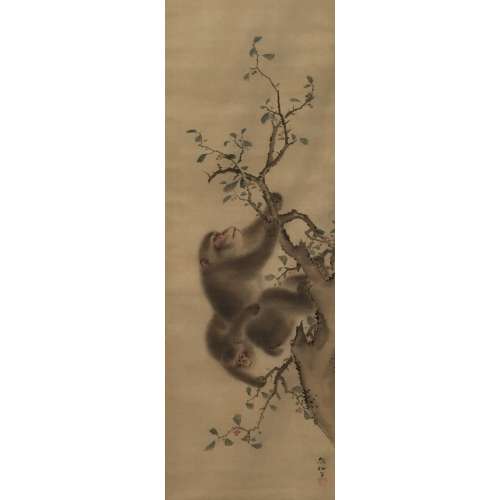 Mori Sosen (1747-1821). Two Monkeys Hanging From Branches. Hanging Scroll Painting. Ink and colour on silk. Signed: Sosen. Sealed: Sosen.
Mori Sosen (1747-1821). Two Monkeys Hanging From Branches. Hanging Scroll Painting. Ink and colour on silk. Signed: Sosen. Sealed: Sosen. -
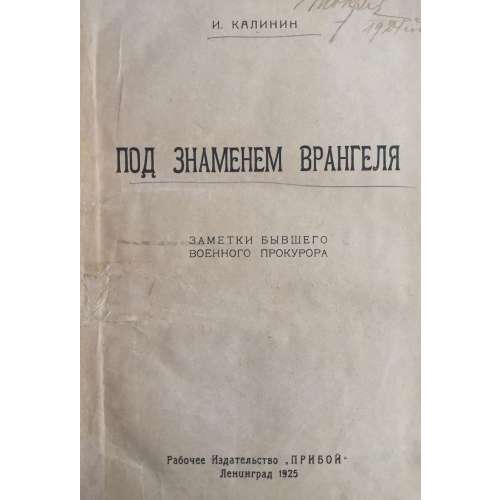
И. М. Калинин. Под знаменем Врангеля. Заметки бывшего военного прокурора. - Л.: Рабочее из-во "Прибой", 1925. - 273 с.
Тираж 7125 экз.
Об авторе: «К моменту февральской революции я занимал должность помощника военного прокурора Кавказского военно-окружного суда... Я не был политиком, но не переносил Союза русского народа. Падение монархии приветствовал. В 1917 году в г. Эрзеруме, занимая довольно приличный пост, работал в самом тесном содружестве с Советом солдатских и рабочих депутатов. Меньшевики, эсэры, большевики постоянно навещали меня, зная, что я хотя и внепартийный, но искренно предан делу революции». В 1918-м Калинину удалось перебраться в занятый Добровольческой армией Екатеринодар, откуда в конце сентября 1918 г. он выехал на Дон. «Здесь тоже мобилизовали всех офицеров. Мне ничего другого не оставалось, как поступить на службу в только что сорганизованный Донской военно-окружной суд». Будучи профессиональным военным юристом Калинин в дальнейшем состоял прокурором при временном Донском военном суде.
По возвращении из эмиграции полковник Калинин, как и многие другие репатрианты, пытался избавиться от клейма «бывшего белогвардейца». 5 октября 1937 г. И. М. Калинин, в то время преподаватель рабочего факультета Ленинградского автодорожного института, был арестован по решению Комиссии НКВД и Прокуратуры СССР . 2 ноября 1937 г. он был приговорен по ст. 58-6-8-11 УК РСФСР к высшей мере наказания и расстрелян в Ленинграде 10 ноября 1937 года.
-
 Shakudō tsuba of the slightly vertically elongated round form (nagamaru-gata) decorated by gold in flat inlay (hira-zōgan) with three insects (cricket, locust, and praying mantis), grass and dewdrops motif. Kogai hitsu-ana is plugged with gilded soft metal. Height: 70.2 mm; width: 66.4 mm x Thickness at seppa-dai: 4.5 mm. Edo period (from ca. 1700 to ca. 1850) Unsigned. Attributed to Kaga School or Murakami School. Almost identical tsuba (no dewdrops, though) is illustrated and described at page 60 of Kokusai Tosogu Kai. 7th International Convention & Exhibition, November 1st, 2011 at Tokyo National Museum, page 60. It is attributed to the Kaga School, Mid Edo period (Late 17th - early 18th century). Dimensions: 70.5 x 66 x 4.5 mm. "The rich black shakudo plate has been slightly lowered (dished out) and then polished. Gold insects crawl amongst grasses, depicted by Kaga style hirazogan (flat inlay). One tendril of the mantis overlaps onto seppa-dai. The mantis boldly looks out from the tsuba in a curious way. This style of Kaga tsuba was popular during the Genroku era (1688-1703)."Another source is Japanese Sword Fittings. A descriptive catalogue of the Collection of G.H. Naunton, Esq., completed and illustrated by Henri L. Joly, - 1912:
Shakudō tsuba of the slightly vertically elongated round form (nagamaru-gata) decorated by gold in flat inlay (hira-zōgan) with three insects (cricket, locust, and praying mantis), grass and dewdrops motif. Kogai hitsu-ana is plugged with gilded soft metal. Height: 70.2 mm; width: 66.4 mm x Thickness at seppa-dai: 4.5 mm. Edo period (from ca. 1700 to ca. 1850) Unsigned. Attributed to Kaga School or Murakami School. Almost identical tsuba (no dewdrops, though) is illustrated and described at page 60 of Kokusai Tosogu Kai. 7th International Convention & Exhibition, November 1st, 2011 at Tokyo National Museum, page 60. It is attributed to the Kaga School, Mid Edo period (Late 17th - early 18th century). Dimensions: 70.5 x 66 x 4.5 mm. "The rich black shakudo plate has been slightly lowered (dished out) and then polished. Gold insects crawl amongst grasses, depicted by Kaga style hirazogan (flat inlay). One tendril of the mantis overlaps onto seppa-dai. The mantis boldly looks out from the tsuba in a curious way. This style of Kaga tsuba was popular during the Genroku era (1688-1703)."Another source is Japanese Sword Fittings. A descriptive catalogue of the Collection of G.H. Naunton, Esq., completed and illustrated by Henri L. Joly, - 1912:
7-U17. Ron Hartmann Collection.
Kanazawa in Kaga was a centre of fine metal work during the whole of the Tokugawa period. At first the inlayers of Fushimi following the Daimyo Maeda went to Kanazawa, then some of the Gotō masters proceeded from Kyoto for short periods to work for the Daimyo, so that their influence was strongly impressed upon Kaga work..." A somewhat look-a-like tsuba is illustrated at plate XXVIII, Kaga Inlay, №653 with the following description at page 52: "Shakudō, inlaid with five insects in gold: crickets, praying mantis, grasshopper, in the style of Takagawara Ujitsugu.
According to M. Sesko, Ujitsugu was a master from Katsuki and Kaneko School in Kaga, son of Ujihira. Ujihira's father Ujiyoshi died in 1802. This brings us to the mid-19th century, instead of mid-18th or earlier. On the other hand, a very much look alike specimen at MFA collection (ACCESSION NUMBER 17.1061) has the with the following description: Edo period. Late 18th–early 19th century. Murakami School. Main material: shakudo; other metals: gold; decorative technique: iroe hirazogan.A detailed account of Murakami school can be found at The Japanese toso-kinko Schools.// Lulu Inc., 2012 by Markus Sesko, on pages 235-239. All-in-all, it's either Kaga School or Murakami School, either ca. 1700 or ca. 1850. Quite a range! SOLD
MFA # 17.1061
-
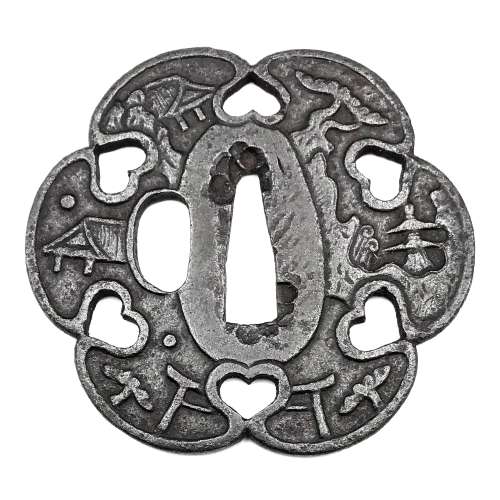 Iron tsuba of six-lobed (mutsu-mokkō-gata) form, with six wild boar's eye shape (inome) openings (sukashi). Hitsu-ana and the entire perimeter of tsuba have typical for this school raised rim. Lobes are decorated with landscape motifs in low relief carving (sukidashi-bori). On the obverse: A hut under a full moon, Shinto shrine gates (torii) with pines and a full moon, rocks, a large pine tree, and a temple (pagoda) surrounded by rocks and waves. On the reverse: waves, fishing boat, wild gees in flight under full moon, maple, hexagon (tortoiseshell, kikko) with a dot inside and a dot outside (inclusion/exclusion symbol), and chrysanthemum (the last two may be family crests, mon). Kamakura-bori school. Late Muromachi period (1514-1573). Height: 64.2 mm, width: 74.3 mm, Thickness at seppa-dai: 3.2 mm, at rim 2.6 mm. Weight: 62.8 g (light). NBTHK old green certificate №561: Tokubetsu Kicho - "Extraordinary Work". A look-a-like tsuba can be found at the Compton Collection, part II, pp. 14-15, №17, though his tsuba is more massive (80 x 84 x 4 mm).NBTHK paper says that the motif is Hakkei (八景), i.e. "Eight Views," so several interpretations are possible (the original Chinese ones, Omi Hakkei, etc.). However, most likely it is the 'Eight views of Omi' (近江八景 - 'Omi Hakkei'). Why the artist selected a 6-lobed form for depicting 8 views remains unclear, and thus we are in our right to raise the question whether the motif is indeed Hakkei. The term Omi hakkei (eight views of Omi) refers to painting or print sets which illustrate life on the shores of Lake Biwa in Omi (now Shiga Prefecture). The model for such paintings came from China, where, from the eleventh century onward, painters had produced eight views of the Hsiao and Hsiang lake areas of Hunan Province. The themes, which follow the original Chinese models, are: geese descending to land, returning fishing boats, clearing rain, a snow-covered evening landscape, the autumn moon, night rain, a temple bell at evening, and the glow of sunset. Japanese artists have also used the eight-theme approach for other parts of country - including cities - and applied it to subject matter other than landscapes. [Merrily Baird. Symbols of Japan. Thematic motifs in art and design. Rizzoli international publications, Inc., 2001, page 308-9]. Japan Encyclopedia by Louis Frédéric also mentions Omi Hakkei as "Eight landscapes of Omi", and states that this theme was often cited in poetry after 1500. It is likely that the tsuba in focus is designed under the influence of the theme popularity in the 16th century. The theme was effectively exploited by prominent ukiyo-e artists Suzuki Harunobu and Utagawa Hiroshige in the 18th and 19th century, respectively. These are the eight scenes of the theme (see Wikipedia):
Iron tsuba of six-lobed (mutsu-mokkō-gata) form, with six wild boar's eye shape (inome) openings (sukashi). Hitsu-ana and the entire perimeter of tsuba have typical for this school raised rim. Lobes are decorated with landscape motifs in low relief carving (sukidashi-bori). On the obverse: A hut under a full moon, Shinto shrine gates (torii) with pines and a full moon, rocks, a large pine tree, and a temple (pagoda) surrounded by rocks and waves. On the reverse: waves, fishing boat, wild gees in flight under full moon, maple, hexagon (tortoiseshell, kikko) with a dot inside and a dot outside (inclusion/exclusion symbol), and chrysanthemum (the last two may be family crests, mon). Kamakura-bori school. Late Muromachi period (1514-1573). Height: 64.2 mm, width: 74.3 mm, Thickness at seppa-dai: 3.2 mm, at rim 2.6 mm. Weight: 62.8 g (light). NBTHK old green certificate №561: Tokubetsu Kicho - "Extraordinary Work". A look-a-like tsuba can be found at the Compton Collection, part II, pp. 14-15, №17, though his tsuba is more massive (80 x 84 x 4 mm).NBTHK paper says that the motif is Hakkei (八景), i.e. "Eight Views," so several interpretations are possible (the original Chinese ones, Omi Hakkei, etc.). However, most likely it is the 'Eight views of Omi' (近江八景 - 'Omi Hakkei'). Why the artist selected a 6-lobed form for depicting 8 views remains unclear, and thus we are in our right to raise the question whether the motif is indeed Hakkei. The term Omi hakkei (eight views of Omi) refers to painting or print sets which illustrate life on the shores of Lake Biwa in Omi (now Shiga Prefecture). The model for such paintings came from China, where, from the eleventh century onward, painters had produced eight views of the Hsiao and Hsiang lake areas of Hunan Province. The themes, which follow the original Chinese models, are: geese descending to land, returning fishing boats, clearing rain, a snow-covered evening landscape, the autumn moon, night rain, a temple bell at evening, and the glow of sunset. Japanese artists have also used the eight-theme approach for other parts of country - including cities - and applied it to subject matter other than landscapes. [Merrily Baird. Symbols of Japan. Thematic motifs in art and design. Rizzoli international publications, Inc., 2001, page 308-9]. Japan Encyclopedia by Louis Frédéric also mentions Omi Hakkei as "Eight landscapes of Omi", and states that this theme was often cited in poetry after 1500. It is likely that the tsuba in focus is designed under the influence of the theme popularity in the 16th century. The theme was effectively exploited by prominent ukiyo-e artists Suzuki Harunobu and Utagawa Hiroshige in the 18th and 19th century, respectively. These are the eight scenes of the theme (see Wikipedia):
Compton Collection, part II, pp. 14-15, №17: Kamakura-bori tsuba, ca. 1450.
- Returning sails at Yabase (矢橋の帰帆) - Yabase. Yabase is an old harbour on the east side of the lake. Near the Tokaido, it was used for a shortcut to Otsu by boat.
- Evening glow at Seta (勢多(瀬田)の夕照) - The Chinese Bridge at Seta. The long bridge across the Seta was used by the Tokaido. In the background the "Fuji of Omi", the Mikamiyama. It is just above 400 m, but indeed well visible.
- Autumn moon at Ishiyama (石山の秋月) - Ishiyama Temple. The Ishiyamadera was located on a hillside next to the Seta River. It got his name form the strange rocks on which it is built, partly on supporting beams. A hut at the upper end of the site allows a view of the lake, and the moon.
- Clear breeze at Awazu (粟津の晴嵐) - Awazuhara. Awazu is well known for its pine wood, Awazu-ga-hara.
- Evening bell at Miidera (三井晩鐘) - Mii-dera. Miidera temple was built in the 8th century. Its famous bell is one of the "Three bells of Japan", the other two being those at Byoodo-in, Uji and at Jingoji, Kyoto.
- Evening rain at Karasaki (唐崎の夜雨) - Karasaki Shrine. Karasaki is a small cape with a single large pine tree, a hitsu-matsu.
- Wild geese returning home at Katata (堅田の落雁) - Ukimido. Alighting geese cannot be seen always, however the little temple near Katata in the square hōkyō-style, detached from the lakeside, connected by a bridge. The first part of the name uki is the same as in Ukiyo-e, meaning floating. Midō means temple.
- Evening snow at Hira (比良の暮雪) - Hira Mountains. The Hira mountains on the west side of the lake experience the hard winter, when the winter monsoon brings much snow from the continent.


